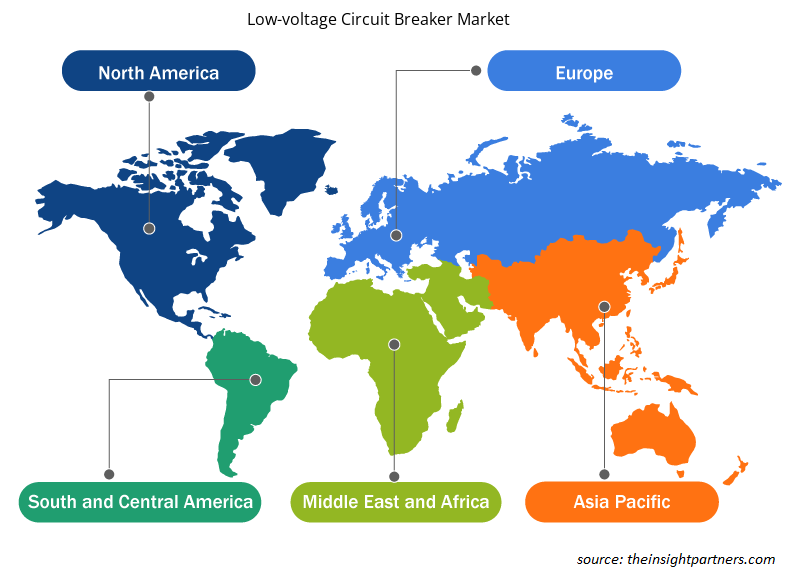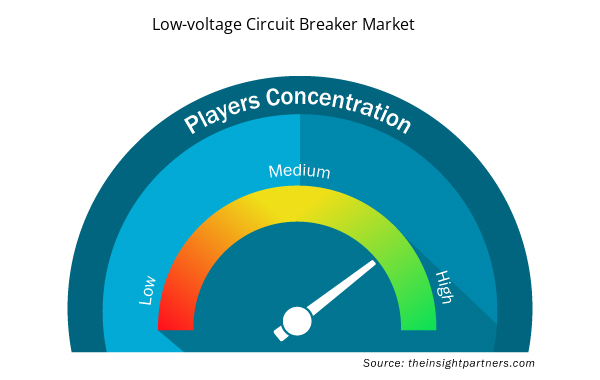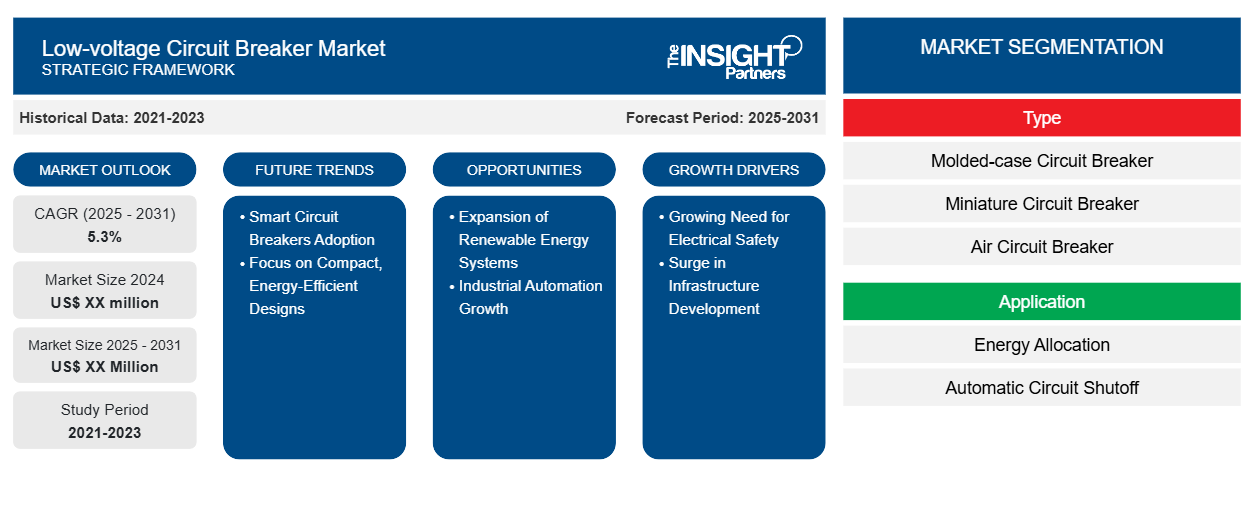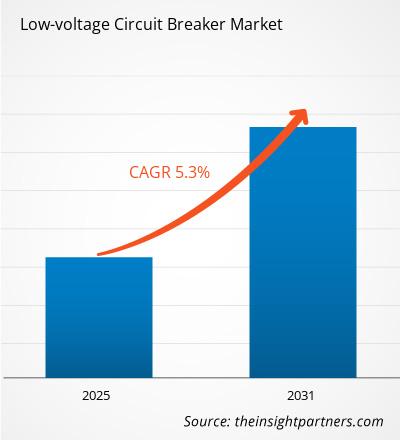Si prevede che il mercato degli interruttori automatici a bassa tensione registrerà un CAGR del 5,3% dal 2024 al 2031, con una dimensione di mercato in espansione da XX milioni di dollari nel 2024 a XX milioni di dollari entro il 2031.
Il report è segmentato per Tipo (Molded-case Circuit Breaker (MCCB); Miniature Circuit Breaker (MCB); e Air Circuit Breaker (ACB)); Applicazione (Energy Allocation e Automatic Circuit Shutoff). L'analisi globale è ulteriormente suddivisa a livello regionale e nei principali Paesi. Il report offre il valore in USD per l'analisi e i segmenti di cui sopra.
Scopo del rapporto
Il report Low-voltage Circuit Breaker Market di The Insight Partners mira a descrivere il panorama attuale e la crescita futura, i principali fattori trainanti, le sfide e le opportunità. Ciò fornirà spunti a vari stakeholder aziendali, come:
- Fornitori/produttori di tecnologia: per comprendere le dinamiche di mercato in evoluzione e conoscere le potenziali opportunità di crescita, consentendo loro di prendere decisioni strategiche informate.
- Investitori: condurre un'analisi completa delle tendenze in merito al tasso di crescita del mercato, alle proiezioni finanziarie del mercato e alle opportunità esistenti lungo la catena del valore.
- Enti di regolamentazione: regolamentano le politiche e le attività di controllo sul mercato allo scopo di ridurre al minimo gli abusi, preservare la fiducia degli investitori e sostenere l'integrità e la stabilità del mercato.
Segmentazione del mercato degli interruttori automatici a bassa tensione
Tipo
- Interruttore automatico in scatola stampata
- Interruttore automatico in miniatura
- Interruttore automatico dell'aria
Applicazione
- Assegnazione dell'energia
- Spegnimento automatico del circuito
Personalizza questo report in base alle tue esigenze
Riceverai la personalizzazione gratuita di qualsiasi report, comprese parti di questo report, o analisi a livello nazionale, pacchetto dati Excel, oltre a usufruire di grandi offerte e sconti per start-up e università
- Scopri le principali tendenze di mercato in questo rapporto.Questo campione GRATUITO includerà analisi di dati che spaziano dalle tendenze di mercato alle stime e alle previsioni.
Fattori trainanti della crescita del mercato degli interruttori automatici a bassa tensione
- Crescente necessità di sicurezza elettrica: la crescente complessità dei sistemi elettrici in contesti residenziali, industriali e commerciali aumenta la necessità di sistemi di protezione affidabili. Gli interruttori automatici a bassa tensione forniscono una sicurezza essenziale prevenendo sovraccarichi elettrici, cortocircuiti e incendi elettrici. Man mano che l'infrastruttura elettrica diventa più intricata con un aumento di dispositivi intelligenti e macchinari pesanti, la domanda di questi interruttori automatici cresce. Il loro ruolo nella protezione sia della sicurezza umana che di apparecchiature di valore da guasti elettrici li rende indispensabili nelle moderne reti elettriche, alimentando la crescita del mercato.
- Aumento dello sviluppo delle infrastrutture: l'urbanizzazione e la crescita industriale sono i principali motori del mercato degli interruttori automatici a bassa tensione. Poiché i paesi, in particolare nell'area Asia-Pacifico e nel Medio Oriente, sperimentano un rapido sviluppo delle infrastrutture, aumenta la domanda di sistemi elettrici che garantiscano una distribuzione affidabile e sicura. Queste regioni stanno espandendo le loro infrastrutture residenziali, commerciali e industriali, che richiedono una sofisticata protezione elettrica. Gli interruttori automatici a bassa tensione sono essenziali in questi contesti per garantire il funzionamento efficiente e sicuro delle reti elettriche, creando opportunità di crescita sia nei mercati emergenti che in quelli sviluppati.
Tendenze future del mercato degli interruttori automatici a bassa tensione
- Adozione di interruttori automatici intelligenti: la tendenza verso gli interruttori automatici intelligenti sta prendendo piede in vari settori. Questi interruttori, dotati di funzionalità IoT, consentono il monitoraggio e la gestione da remoto dei sistemi elettrici, fornendo informazioni in tempo reale sullo stato e sulle prestazioni del sistema. Gli interruttori automatici intelligenti offrono funzionalità avanzate come la manutenzione predittiva e il rilevamento dei guasti, riducendo i tempi di inattività e aumentando l'efficienza energetica. Questa crescente domanda di sistemi più intelligenti ed efficienti sta rimodellando il mercato degli interruttori automatici a bassa tensione, in particolare in settori come quelli residenziali, industriali e commerciali, in cui affidabilità e automazione sono fondamentali.IoT capabilities, enable remote monitoring and management of electrical systems, providing real-time insights into system health and performance. Smart circuit breakers offer enhanced features such as predictive maintenance and fault detection, reducing downtime and increasing energy efficiency. This growing demand for smarter, more efficient systems is reshaping the low voltage circuit breaker market, particularly in industries like residential, industrial, and commercial sectors, where reliability and automation are crucial.
- Concentrati su design compatti ed efficienti dal punto di vista energetico: poiché l'efficienza energetica sta diventando sempre più critica sia nelle applicazioni residenziali che in quelle industriali, i produttori stanno dando priorità allo sviluppo di interruttori automatici compatti ed efficienti dal punto di vista energetico a bassa tensione. Questi dispositivi consumano meno energia e occupano meno spazio, rispondendo alla domanda di sistemi elettrici più piccoli e più attenti al consumo energetico. Questa tendenza è particolarmente evidente nei moderni edifici intelligenti e nei sistemi di automazione, dove ridurre al minimo lo spreco di energia è una priorità assoluta. Offrendo un consumo energetico ridotto e design salvaspazio, questi interruttori automatici si stanno allineando alle tendenze globali verso la sostenibilità e soluzioni elettriche più ecologiche.
Opportunità di mercato per interruttori automatici a bassa tensione
- Espansione dei sistemi di energia rinnovabile: con la crescente adozione di fonti di energia rinnovabile come l'energia solare ed eolica, c'è una significativa opportunità per gli interruttori automatici a bassa tensione nella gestione di questi sistemi. Questi interruttori sono essenziali per proteggere le installazioni di energia rinnovabile da guasti elettrici, garantendo al contempo la fluida integrazione dell'energia rinnovabile nella rete elettrica. Aiutano a gestire le fluttuazioni delle uscite di energia e a mantenere la stabilità della rete. Mentre i paesi passano a fonti di energia più ecologiche, la domanda di protezione affidabile nei sistemi di energia rinnovabile continua ad aumentare, creando opportunità per i produttori di interruttori automatici a bassa tensione.
- Crescita dell'automazione industriale: la rapida crescita dell'automazione industriale presenta opportunità significative per il mercato degli interruttori automatici a bassa tensione. I processi di produzione automatizzati, la robotica e i macchinari avanzati richiedono una protezione elettrica precisa e affidabile. Gli interruttori automatici a bassa tensione sono essenziali in queste applicazioni per garantire operazioni continue e sicure, prevenendo al contempo danni alle apparecchiature dovuti a guasti elettrici. Poiché sempre più settori, in particolare nell'automotive, nell'elettronica e nella chimica, adottano tecnologie di automazione, la domanda di interruttori automatici affidabili e ad alte prestazioni in grado di gestire le esigenze dei sistemi automatizzati aumenterà, offrendo un potenziale di crescita per gli operatori del mercato.
Approfondimenti regionali sul mercato degli interruttori automatici a bassa tensione
Le tendenze regionali e i fattori che influenzano il mercato degli interruttori automatici a bassa tensione durante il periodo di previsione sono stati ampiamente spiegati dagli analisti di Insight Partners. Questa sezione discute anche i segmenti e la geografia del mercato degli interruttori automatici a bassa tensione in Nord America, Europa, Asia Pacifico, Medio Oriente e Africa e America centrale e meridionale.

- Ottieni i dati specifici regionali per il mercato degli interruttori automatici a bassa tensione
Ambito del rapporto di mercato sugli interruttori automatici a bassa tensione
| Attributo del report | Dettagli |
|---|---|
| Dimensioni del mercato nel 2024 | XX milioni di dollari USA |
| Dimensioni del mercato entro il 2031 | XX milioni di dollari USA |
| CAGR globale (2024 - 2031) | 5,3% |
| Dati storici | 2021-2023 |
| Periodo di previsione | 2025-2031 |
| Segmenti coperti | Per tipo
|
| Regioni e Paesi coperti | America del Nord
|
| Leader di mercato e profili aziendali chiave |
|
Densità degli attori del mercato degli interruttori automatici a bassa tensione: comprendere il suo impatto sulle dinamiche aziendali
Il mercato degli interruttori automatici a bassa tensione sta crescendo rapidamente, spinto dalla crescente domanda degli utenti finali dovuta a fattori quali l'evoluzione delle preferenze dei consumatori, i progressi tecnologici e una maggiore consapevolezza dei vantaggi del prodotto. Con l'aumento della domanda, le aziende stanno ampliando le loro offerte, innovando per soddisfare le esigenze dei consumatori e capitalizzando sulle tendenze emergenti, il che alimenta ulteriormente la crescita del mercato.
La densità degli operatori di mercato si riferisce alla distribuzione di aziende o società che operano in un particolare mercato o settore. Indica quanti concorrenti (operatori di mercato) sono presenti in un dato spazio di mercato in relazione alle sue dimensioni o al valore di mercato totale.
Le principali aziende che operano nel mercato degli interruttori automatici a bassa tensione sono:
- ABB Ltd.
- SCHNEIDER ELETTRICO
- MITSUBISHI ELETTRICA CORPORAZIONE
- SEIMENS AG
- ELETTRICO HANGSHENG
Disclaimer : le aziende elencate sopra non sono classificate secondo un ordine particolare.

- Ottieni una panoramica dei principali attori del mercato degli interruttori automatici a bassa tensione
Punti di forza chiave
- Copertura completa: il rapporto copre in modo completo l'analisi di prodotti, servizi, tipologie e utenti finali del mercato degli interruttori automatici a bassa tensione, fornendo una panoramica olistica.
- Analisi degli esperti: il rapporto è compilato sulla base della conoscenza approfondita di esperti e analisti del settore.
- Informazioni aggiornate: il rapporto garantisce la pertinenza aziendale grazie alla copertura di informazioni recenti e tendenze nei dati.
- Opzioni di personalizzazione: questo report può essere personalizzato per soddisfare le esigenze specifiche del cliente e adattarsi in modo appropriato alle strategie aziendali.
Il rapporto di ricerca sul mercato degli interruttori automatici a bassa tensione può quindi aiutare a guidare il percorso di decodifica e comprensione dello scenario del settore e delle prospettive di crescita. Sebbene possano esserci alcune preoccupazioni valide, i vantaggi complessivi di questo rapporto tendono a superare gli svantaggi.
- Analisi storica (2 anni), anno base, previsione (7 anni) con CAGR
- Analisi PEST e SWOT
- Valore/volume delle dimensioni del mercato - Globale, regionale, nazionale
- Industria e panorama competitivo
- Set di dati Excel


- Mice Model Market
- Occupational Health Market
- Clinical Trial Supplies Market
- Military Rubber Tracks Market
- Health Economics and Outcome Research (HEOR) Services Market
- Nuclear Decommissioning Services Market
- Hydrogen Storage Alloys Market
- Toothpaste Market
- Identity Verification Market
- Asset Integrity Management Market

Report Coverage
Revenue forecast, Company Analysis, Industry landscape, Growth factors, and Trends

Segment Covered
This text is related
to segments covered.

Regional Scope
North America, Europe, Asia Pacific, Middle East & Africa, South & Central America

Country Scope
This text is related
to country scope.
Domande frequenti
Some of the customization options available based on the request are an additional 3-5 company profiles and country-specific analysis of 3-5 countries of your choice. Customizations are to be requested/discussed before making final order confirmation# as our team would review the same and check the feasibility
Integration with Smart Grids and Automation Systems is likely to remain a key trend in the market.
Key players in the low-voltage circuit breaker market include ABB Ltd., SCHNEIDER ELECTRIC, MITSUBISHI ELECTRIC CORPORATION, SEIMENSAG, HANGSHEN ELECTRIC, HANGHAI LIANGXIN ELECTRICAL CO.; LTD, CHINT GROUP, HYUNDAI ELECTRIC & ENERGY SYSTEMS CO. LTD., GENERAL ELECTRIC, and FUJI ELECTRIC
The major factors driving the low-voltage circuit breaker market are:
1. Increasing Demand for Electrification and Energy Efficiency.
2.Rising Industrialization and Urbanization
The Low-voltage Circuit Breaker Market is estimated to witness a CAGR of 5.3% from 2023 to 2031
Trends and growth analysis reports related to Electronics and Semiconductor : READ MORE..
1. ABB Ltd.
2. SCHNEIDER ELECTRIC
3. MITSUBISHI ELECTRIC CORPORATION
4. SEIMENS AG
5. HANGSHEN ELECTRIC
6. HANGHAI LIANGXIN ELECTRICAL CO., LTD
7. CHINT GROUP
8. HYUNDAI ELECTRIC & ENERGY SYSTEMS CO. LTD.
9. GENERAL ELECTRIC
10. FUJI ELECTRIC
The Insight Partners performs research in 4 major stages: Data Collection & Secondary Research, Primary Research, Data Analysis and Data Triangulation & Final Review.
- Data Collection and Secondary Research:
As a market research and consulting firm operating from a decade, we have published and advised several client across the globe. First step for any study will start with an assessment of currently available data and insights from existing reports. Further, historical and current market information is collected from Investor Presentations, Annual Reports, SEC Filings, etc., and other information related to company’s performance and market positioning are gathered from Paid Databases (Factiva, Hoovers, and Reuters) and various other publications available in public domain.
Several associations trade associates, technical forums, institutes, societies and organization are accessed to gain technical as well as market related insights through their publications such as research papers, blogs and press releases related to the studies are referred to get cues about the market. Further, white papers, journals, magazines, and other news articles published in last 3 years are scrutinized and analyzed to understand the current market trends.
- Primary Research:
The primarily interview analysis comprise of data obtained from industry participants interview and answers to survey questions gathered by in-house primary team.
For primary research, interviews are conducted with industry experts/CEOs/Marketing Managers/VPs/Subject Matter Experts from both demand and supply side to get a 360-degree view of the market. The primary team conducts several interviews based on the complexity of the markets to understand the various market trends and dynamics which makes research more credible and precise.
A typical research interview fulfils the following functions:
- Provides first-hand information on the market size, market trends, growth trends, competitive landscape, and outlook
- Validates and strengthens in-house secondary research findings
- Develops the analysis team’s expertise and market understanding
Primary research involves email interactions and telephone interviews for each market, category, segment, and sub-segment across geographies. The participants who typically take part in such a process include, but are not limited to:
- Industry participants: VPs, business development managers, market intelligence managers and national sales managers
- Outside experts: Valuation experts, research analysts and key opinion leaders specializing in the electronics and semiconductor industry.
Below is the breakup of our primary respondents by company, designation, and region:

Once we receive the confirmation from primary research sources or primary respondents, we finalize the base year market estimation and forecast the data as per the macroeconomic and microeconomic factors assessed during data collection.
- Data Analysis:
Once data is validated through both secondary as well as primary respondents, we finalize the market estimations by hypothesis formulation and factor analysis at regional and country level.
- Macro-Economic Factor Analysis:
We analyse macroeconomic indicators such the gross domestic product (GDP), increase in the demand for goods and services across industries, technological advancement, regional economic growth, governmental policies, the influence of COVID-19, PEST analysis, and other aspects. This analysis aids in setting benchmarks for various nations/regions and approximating market splits. Additionally, the general trend of the aforementioned components aid in determining the market's development possibilities.
- Country Level Data:
Various factors that are especially aligned to the country are taken into account to determine the market size for a certain area and country, including the presence of vendors, such as headquarters and offices, the country's GDP, demand patterns, and industry growth. To comprehend the market dynamics for the nation, a number of growth variables, inhibitors, application areas, and current market trends are researched. The aforementioned elements aid in determining the country's overall market's growth potential.
- Company Profile:
The “Table of Contents” is formulated by listing and analyzing more than 25 - 30 companies operating in the market ecosystem across geographies. However, we profile only 10 companies as a standard practice in our syndicate reports. These 10 companies comprise leading, emerging, and regional players. Nonetheless, our analysis is not restricted to the 10 listed companies, we also analyze other companies present in the market to develop a holistic view and understand the prevailing trends. The “Company Profiles” section in the report covers key facts, business description, products & services, financial information, SWOT analysis, and key developments. The financial information presented is extracted from the annual reports and official documents of the publicly listed companies. Upon collecting the information for the sections of respective companies, we verify them via various primary sources and then compile the data in respective company profiles. The company level information helps us in deriving the base number as well as in forecasting the market size.
- Developing Base Number:
Aggregation of sales statistics (2020-2022) and macro-economic factor, and other secondary and primary research insights are utilized to arrive at base number and related market shares for 2022. The data gaps are identified in this step and relevant market data is analyzed, collected from paid primary interviews or databases. On finalizing the base year market size, forecasts are developed on the basis of macro-economic, industry and market growth factors and company level analysis.
- Data Triangulation and Final Review:
The market findings and base year market size calculations are validated from supply as well as demand side. Demand side validations are based on macro-economic factor analysis and benchmarks for respective regions and countries. In case of supply side validations, revenues of major companies are estimated (in case not available) based on industry benchmark, approximate number of employees, product portfolio, and primary interviews revenues are gathered. Further revenue from target product/service segment is assessed to avoid overshooting of market statistics. In case of heavy deviations between supply and demand side values, all thes steps are repeated to achieve synchronization.
We follow an iterative model, wherein we share our research findings with Subject Matter Experts (SME’s) and Key Opinion Leaders (KOLs) until consensus view of the market is not formulated – this model negates any drastic deviation in the opinions of experts. Only validated and universally acceptable research findings are quoted in our reports.
We have important check points that we use to validate our research findings – which we call – data triangulation, where we validate the information, we generate from secondary sources with primary interviews and then we re-validate with our internal data bases and Subject matter experts. This comprehensive model enables us to deliver high quality, reliable data in shortest possible time.


 Ottieni un campione gratuito per questo repot
Ottieni un campione gratuito per questo repot